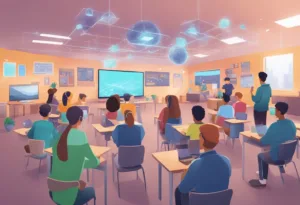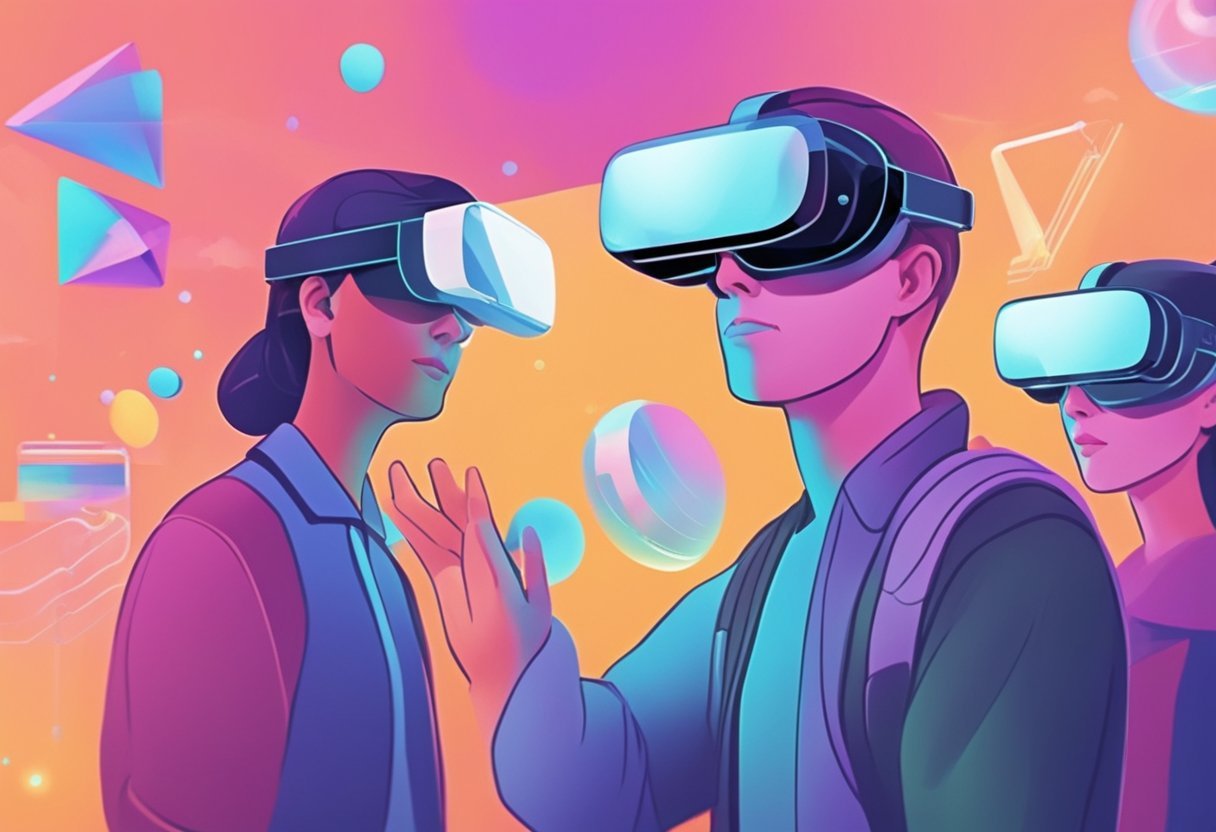Augmented reality (AR) technology overlays digital information such as sounds, videos, and graphics on top of the real-world environment. AR is often confused with virtual reality (VR), a technology that creates entirely artificial environments. Augmented reality learning has become increasingly popular in recent years, as it allows students to interact with digital content in a more interactive and engaging way.
AR can be used in a variety of educational settings, from primary schools to universities. It can help students visualize complex concepts and theories, making it easier for them to understand and remember. AR can also provide students with hands-on experience in a safe and controlled environment, allowing them to practice and perfect their skills before applying them in the real world.
What is augmented reality learning?
Augmented reality (AR) is a technology that overlays digital information onto the physical world. AR learning enables students to interact with digital content in a real-world context, enhancing their learning experience. With AR, learners can see, hear, and interact with information in a way that is not possible with traditional learning methods.
How can augmented reality be used in learning?
AR can be used in various ways to make learning more engaging and interactive. For example, AR can be used to create simulations that allow learners to practice real-world skills in a safe and controlled environment. AR can also be used to bring historical events to life, allowing learners to experience history in a more immersive way.
How to use augmented reality in the classroom
To use AR in the classroom, you need a device that is capable of displaying AR content. This can be a smartphone, tablet, or AR headset. You also need AR software that can create and display AR content. There are many AR apps available that can be used in the classroom, such as AR flashcards, AR quizzes, and AR simulations.
Benefits of using augmented reality in education
AR learning has many benefits for students. It can increase engagement and motivation, as learners are more likely to be interested in learning when it is presented in an interactive and immersive way. AR can also improve retention and recall, as learners are more likely to remember information that they have interacted with in a real-world context.
How hard is it to learn augmented reality?
Learning AR can be challenging, as it requires knowledge of computer graphics, computer vision, and AR technology. However, there are many resources available that can help you learn AR, such as online courses, tutorials, and forums. With practice and dedication, anyone can learn AR and create engaging and interactive learning experiences for their students.
AR learning is a powerful tool that can enhance the learning experience for students. By using AR in the classroom, you can create engaging and interactive learning experiences that can improve student engagement, retention, and recall. With the right tools and resources, anyone can learn AR and create immersive learning experiences for their students.
AR in Education and Training

Augmented Reality (AR) technology has been gaining traction for its potential to enhance the learning experience in both traditional and remote classroom settings. AR technology can provide students with a more interactive and engaging learning experience, making it easier for them to understand complex concepts.
Learning Experience Enhancement
AR technology can enhance the learning experience by providing students with a more immersive and interactive way of learning. By using AR apps and headsets, students can visualize concepts in 3D and interact with them in real-time. This can help students understand complex concepts more easily and retain the information better.
Applications in Classroom and Remote Learning
AR technology can be used in both traditional and remote classroom settings. In traditional classrooms, AR can be used to create interactive learning experiences that engage students and make learning more fun. In remote classrooms, AR can be used to create virtual classrooms where students can interact with each other and their teachers in real-time.
Military and Medical Training
AR technology is also being used in military and medical training to simulate real-world scenarios. Military personnel can use AR technology to simulate combat situations and practice their skills in a safe environment. Medical professionals can use AR technology to practice surgical procedures and diagnose patients more accurately.
AR technology is accessible through smartphones and other mobile devices, making it easier for students to access and use. With the potential to revolutionize the way we learn, AR technology is set to become an integral part of the education and training industry.
Industry Applications of AR
Augmented Reality has become an increasingly popular technology in various industries. It has been used to enhance the user experience in many ways, from engineering and manufacturing to retail and entertainment. Here are some of the industry applications of AR that have been implemented successfully:
Engineering and Manufacturing
AR has been used in engineering and manufacturing to provide workers with real-time data visualization. This technology allows workers to make timely data-driven decisions, collaborate across teams, and simplify manufacturing workflows. AR also helps in prototyping, where designers can visualize their designs in a real-world environment before manufacturing.
Retail and Entertainment
AR has been used in the retail industry to enhance the shopping experience. AR allows customers to try on clothes and accessories virtually, visualize how furniture would look in their homes, and even see how makeup would look on their faces. In the entertainment industry, AR has been used to create interactive experiences in theme parks, museums, and other attractions.
Construction and Real Estate
AR has been used in construction and real estate to help architects and builders visualize their designs in real-world environments. AR technology can be used to overlay digital information onto physical spaces, allowing architects and builders to see how their designs would look in the real world. In real estate, AR can be used to provide virtual tours of properties, allowing potential buyers to see what a property would look like without having to physically visit it.
AR technology has proven to be a valuable tool in many industries, providing workers and customers with a unique and enhanced experience. As the technology continues to advance, we can expect to see even more innovative applications of AR in the future.
Developing AR Applications

Augmented Reality (AR) is a technology that can provide an immersive learning experience. Developing AR applications can be a challenging task that requires knowledge of AR development platforms, 3D objects, image recognition, and coding. In this section, we will explore the different aspects of developing AR applications.
AR Development Platforms
AR development platforms, such as Unity, can be used to create AR applications. Unity is a popular AR development platform that offers a wide range of features and tools to create AR applications. Unity can be used to create AR applications for various platforms, including Android and iOS. Unity supports different AR devices, such as AR headsets and AR glasses.
3D Objects and Image Recognition
AR applications require 3D objects and image recognition to provide an immersive experience. 3D objects can be created using 3D modeling software, such as Blender. Image recognition is used to detect the real-world environment and overlay digital objects on it. AR applications use computer vision algorithms to recognize images and objects in the real world. Machine learning can also be used to improve tracking accuracy.
Challenges in AR App Development
Developing AR applications can be challenging due to the need for compatibility and consistent performance across different devices, environment conditions, and software versions. Ensuring that the AR application performs consistently across different devices, such as smartphones and AR headsets, can be a challenging task. Testing the AR application in different environments can be time-consuming.
Developing AR applications requires knowledge of AR development platforms, 3D objects, image recognition, and coding. AR applications provide an immersive learning experience and can be challenging to develop due to compatibility and performance issues.
The Future of Augmented Reality
Augmented reality (AR) is a technology that has revolutionized the way we interact with the world around us. With the increasing popularity of AR, it is no surprise that the AR market is expected to grow significantly in the coming years. According to a report by MarketsandMarkets, the AR market is expected to reach $72.7 billion by 2024, growing at a CAGR of 37.0% during the forecast period.
As machine learning continues to advance, it is expected that AR will become even more prevalent in our daily lives. Machine learning algorithms can be used to create more personalized AR experiences, making it easier for users to interact with the technology.
AR has the potential to transform the digital economy by creating new opportunities for businesses to engage with customers. For example, retailers can use AR to create virtual try-on experiences for customers, allowing them to see how products will look before making a purchase. This can lead to increased customer satisfaction and higher sales for businesses.
As AR technology continues to evolve, it is expected that it will become even more integrated into our daily lives. From education to entertainment, AR has the potential to transform the way we interact with the world around us. With the increasing popularity of AR, it is clear that this technology has a bright future ahead of it.
Frequently Asked Questions
How is augmented reality applied in educational settings?
Augmented reality is applied in educational settings to enhance the learning experience by providing a more interactive and immersive experience. It allows students to visualize concepts and ideas in a way that traditional methods cannot. For example, students can use augmented reality to explore historical sites, view three-dimensional models of complex structures, and simulate scientific experiments. This technology can also be used to gamify learning, making it more engaging and enjoyable for students.
What are some examples of augmented reality enhancing the learning experience?
Augmented reality has been used to enhance the learning experience in various ways. For instance, students can use augmented reality to learn about the human body by exploring it in three dimensions. They can also use augmented reality to explore different parts of the world, such as famous landmarks, museums, and historical sites. Augmented reality can also be used to simulate scientific experiments, allowing students to learn about scientific concepts in a more interactive and engaging way.
What are the benefits of integrating augmented reality into educational curricula?
Integrating augmented reality into educational curricula can have several benefits. Firstly, it can make learning more engaging and interactive, leading to better retention of information. Secondly, it can help students visualize complex concepts and ideas in a way that traditional methods cannot. Thirdly, it can help students develop critical thinking and problem-solving skills by presenting them with real-world scenarios to solve. Finally, it can help students develop digital literacy skills, which are essential in today’s world.
How can educators access free augmented reality applications for teaching purposes?
Educators can access free augmented reality applications for teaching purposes by searching for them on app stores such as Google Play and the Apple App Store. Many educational institutions also offer free augmented reality applications to their students. There are several websites that offer free augmented reality applications for educational purposes.
What emerging trends in augmented reality should educators be aware of?
Educators should be aware of emerging trends in augmented reality, such as the use of augmented reality in online learning and virtual classrooms. They should also be aware of the increasing availability of augmented reality hardware, such as smart glasses, which can provide a more immersive experience. Finally, educators should be aware of the increasing use of augmented reality in vocational training, where it can be used to simulate real-world scenarios.
What kind of training or education is required to develop augmented reality learning programs?
Developing augmented reality learning programs requires a combination of technical and educational expertise. Educators should have a solid understanding of the subject matter they are teaching, as well as experience in instructional design. Technical expertise in programming and 3D modeling is also required. There are several online courses and programs available that can provide the necessary training and education for developing augmented reality learning programs.




